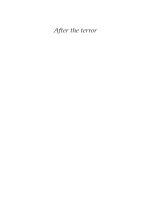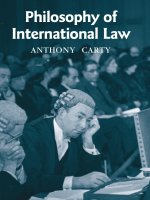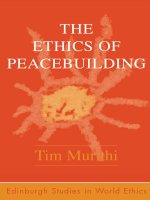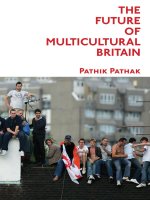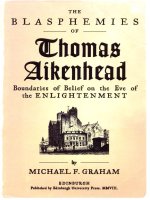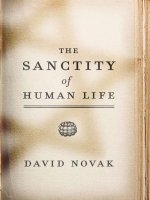edinburgh university press the kennedy assassination jan 2007
Bạn đang xem bản rút gọn của tài liệu. Xem và tải ngay bản đầy đủ của tài liệu tại đây (1.49 MB, 193 trang )
‘Peter Knight’s book on the Kennedy assassination is the best available
source we have on the most symptomatic event of postwar American
history. Encyclopedic in scope, elegant and clear in its execution, wide-
ranging in its assessment of the history and representational aftermath
of that dark day in Dallas, this will be the “go-to” book on the Kennedy
assassination for some time to come.’
Patrick O’Donnell, Chair of the Department of English, Michigan
State University
Representing American Events
Series Editors
Tim Woods and Helena Grice, both at the University of Wales,
Aberystwyth
Forthcoming titles in the series include:
9/11 and the War on Terror
by David Holloway
The Moon Landing
by Alasdair Spark
The Kennedy Assassination
Peter Knight
Edinburgh University Press
© Peter Knight, 2007
Edinburgh University Press Ltd
22 George Square, Edinburgh
Typeset in Janson and Helvetica
by Servis Filmsetting Ltd, Manchester and
printed and bound in Great Britain by
Cromwell Press, Trowbridge, Wilts
A CIP record for this book is available from the British Library
ISBN 978 0 7486 2410 2 (hardback)
ISBN 978 0 7486 2411 9 (paperback)
The right of Peter Knight
to be identified as author of this work
has been asserted in accordance with
the Copyright, Designs and Patents Act 1988.
Contents
List of Illustrations vi
Series Editors’ Preface vii
Acknowledgements ix
1. Introduction 1
2. Journalism 9
3. History 23
4. The Official Version 42
5. The Unofficial Version 75
6. Literature 105
7. Visual Culture and Film 133
Conclusion 162
Further Reading 165
Bibliography 167
Index 175
List of Illustrations
Fig. 1.1 Love Field, Dallas, 23 November 1963. 2
Fig. 2.1 Walter Cronkite announcing on CBS television
the death of President Kennedy. 19
Fig. 4.1 Contents of Marina Oswald’s medicine
cabinet (Commission Exhibit 121). 64
Fig. 5.1 ‘Magic Bullet’ (Commission Exhibit 399). 81
Fig. 5.2 Autopsy Face Sheet (‘Boswells’ face sheet’)
(Commission Exhibit 397). 83
Fig. 7.1 Zapruder frame 313. 135
Fig. 7.2 Secrets of a Homicide. 140
Fig. 7.3 Backyard photo of Oswald (Commission
Exhibit 133A). 143
Fig. 7.4 Jack Ruby shooting Lee Harvey Oswald. 145
Fig. 7.5 Andy Warhol, Jackie (The Week That Was)
(1963), acrylic and silkscreen ink on canvas. 148
vi
Series Editors’ Preface
The principal aim of the Representing American Events series is to
provide reliable books that focus on selected key events within
American history from the perspective of several different disciplines,
including cultural studies, politics and literary studies. In other words,
the series aims not simply to provide distinctive interpretations of sig-
nificant American events, but to provide a cross-sectional analysis of
the ‘event’, offering readers a range of disciplinary perspectives on one
particular historical event.
There are many American Studies books that focus upon historical
events within the twentieth century. However, for the most part, these
books approach the historical events in a diachronic manner, that is
looking at multiple historical events and their consequences usually
through the perspective of a single disciplinary focus through time. The
main innovative aim of this series is to consider a single historical event
through the perspective of multiple disciplinary foci, in a more syn-
chronic manner; that is, taking a cross-section of the various discourses
that represent the event. The main idea, therefore, is to provide readers
with books that analyse the contexts and co-texts of historical events in
different disciplines in a cross-sectional manner. These ‘events’ might
have lasted a few minutes (the assassination of John F. Kennedy), a few
hours (the 9/11 Twin Towers catastrophe), a day (the attack on Pearl
Harbor), several days or months (the moonlanding project), or several
years (the Great Depression), but in all cases, the ‘event’ has become
something of a landmark in the development of the Unites States in the
twentieth century. The series aims to present students with books that
are informative about the historical event itself, but that take a lateral
perspective on the ways in which the event has been represented in the
principal contexts and co-texts of historical, literary, cinematic, politi-
cal, sociological and artistic discourses. The series also aims to consider
the ways in which the ‘event’ has been represented in subsequent years
in these different discourses.
vii
Characteristically, each chapter in each series volume will focus pri-
marily on a few instances of ‘case studies’ of key ‘co-texts’ within the
particular discourses under scrutiny. However, the chapters will also
discuss other texts within the general domain of that particular dis-
course. So, for example, a chapter on literary representations might
include a sample of two or three key co-texts, but situate these within
a wider literary-historical perspective, i.e., within literary modernism,
or within genre, or within a more general discussion of other literary
texts.
In order to provide authoritative books that are organised with a par-
ticular historically informative focus rather than a primarily argumen-
tative or ideological basis, these books aim to be a hybrid of the
informed student textbook and an academically focused monograph.
Taken together, the series aims to provide undergraduate students with
reliable and informative contextualised surveys of the representation
and development of American culture. In so doing, the Series Editors
have commissioned books for the Representing American Events series
from established authoritative scholars in their respective fields. While
each volume will primarily focus on the event under consideration, we
hope that this series will construct a repertoire of up-to-date and con-
temporary perspectives on the United States in the past century, that
will in turn advance debates about American society and culture into
the twenty-first century.
Tim Woods
Helena Grice
viii
THE KENNEDY ASSASSINATION
Acknowledgements
Grateful acknowledgement is made to the following sources for per-
mission to reproduce material in this book previously published else-
where. Every effort has been made to trace copyright holders, but if any
have been inadvertently overlooked the publisher will be pleased to
make the necessary arrangement at the first opportunity.
Dallas Arrival, 22 Nov. 1963. Time & Life Pictures. By Art Rickerby.
© Getty Images.
Walter Cronkite Announces Kennedy Death, 22 Nov. 1963. Hulton
Archive. By CBS Photo Archive. © Getty Images.
Contents of Marina Oswald’s medicine cabinet (Commission Exhibit
121). Courtesy JFK Assassination Records Collection, US National
Archives & Records Administration.
‘Magic Bullet’ (Commission Exhibit 399). Courtesy JFK Assassin-
ation Records Collection, US National Archives & Records
Administration.
Autopsy Face Sheet (‘Boswells’ face sheet’) (Commission Exhibit 397).
Courtesy JFK Assassination Records Collection, US National Archives
& Records Administration.
Zapruder Frame 313 © 1967 (renewed 1995), The Sixth Floor
Museum at Dealey Plaza. All Rights Reserved.
Secrets of a Homicide: The JFK Assassination. © 1995–2006 Dale
K. Myers. Reprinted by permission of Dale K. Myers. www.jfkfiles.
com
ix
Backyard photo of Oswald (Commission Exhibit 133A). Courtesy JFK
Assassination Records Collection, US National Archives & Records
Administration.
Jack Ruby shooting Lee Harvey Oswald. © Bob Jackson.
Jackie (That was the week that was) © Licensed by the Andy Warhol
Foundation for the Visual Arts, Inc/ARS, New York and DACS
London 2006.
x
THE KENNEDY ASSASSINATION
1 Introduction
On Friday, 22 November 1963 President John F. Kennedy was assassi-
nated in Dallas. Accompanied by his wife Jacqueline Kennedy, he was
in Texas on a two-day tour that was designed to heal a rift in the
Democratic party in the region, and as an early part of his campaign for
re-election in 1964. Having made a grand arrival by presidential jet at
Dallas Love Field airport from their previous stop in Forth Worth
(even though it was only thirty miles by car), Kennedy and his wife were
greeted by a surprisingly enthusiastic crowd on the sunny November
day with bright blue skies (see fig. 1.1). Mrs Kennedy had kept out of
the public limelight for several months since the death of her newborn
baby in August 1963, and so was delighted to find that the Texas public
greeted her warmly. The motorcade route was scheduled to pass
through downtown on its way to the Dallas Trade Mart, where
Kennedy was to deliver a speech at lunchtime. Despite fears that Dallas
would give the liberal president a hostile welcome (only a month
before, the US Ambassador to the United Nations Adlai Stevenson had
been jostled and spat on by a Dallas crowd), the motorcade was cheered
by a large crowd as it proceeded through downtown Dallas. Just as the
president’s open-top limousine – also carrying Jackie beside JFK, with
Texas Governor John Connally and his wife Nellie Connally in the
jump seats, and two secret service agents in the driving seats – was
entering Dealey Plaza at the edge of the downtown district before the
freeway to the Trade Mart began, several shots rang out at 12.30 p.m.
(Central Standard Time). Kennedy was hit in the back and throat,
Connally was wounded in the chest, wrist and thigh, and then, as the
limousine slowed down with no one quite seeming to realise what was
happening, a final shot exploded Kennedy’s head. Jackie Kennedy
began to crawl over the rear of the car, supposedly trying to rescue frag-
ments of her husband’s skull, but Secret Service Agent Clint Hill who
had been in the follow-up vehicle leapt up onto the presidential limou-
sine and pushed the First Lady back into the seat as the car picked up
1
pace. Leaving behind scenes of chaos and disbelief in Dealey Plaza, the
limousine sped off through a triple underpass to Parkland Hospital a
few miles away, and, despite the efforts of local doctors to revive him,
Kennedy was declared dead at 1 p.m., with the announcement made
2
THE KENNEDY ASSASSINATION
Figure 1.1 Love Field, Dallas, 23 November 1963. Art Rickerby/Getty Images.
public at 1.38 p.m. Vice President Lyndon Johnson (who had also been
in the motorcade in his home state) was then sworn in as president on
board Air Force One, before it took off. The plane also carried
Kennedy’s body and his widow back to Washington, DC.
By 1.50 p.m. a 23-year-old man named Lee Harvey Oswald had been
arrested in a cinema in connection with the shooting at 1.15 p.m. of
Police Officer J. D. Tippit in a residential neighbourhood of Dallas, and
by the time Oswald was brought into the police headquarters the Dallas
Police were indicating that he was also a prime suspect in the killing of
the president. Oswald, however, denied both shootings, apparently
claiming that he was just a ‘patsy’. The police had found a cheap, mail-
order Mannlicher-Carcano rifle and three spent cartridges on the sixth
floor of the Texas School Book Depository overlooking Dealey Plaza,
where Oswald had been working as a shipping clerk. Other evidence
found that weekend seemed to point to Oswald as the assassin, not least
photos that showed him posing with what appeared to be the assassina-
tion rifle and left-wing magazines in the backyard of his house several
months prior to the assassination. It also quickly emerged that Oswald,
a native of New Orleans, was a former Marine and defector to the Soviet
Union, who had returned to the US with his Russian wife and baby in
1961. Back in the US, he had had a series of short-lived jobs, and at the
time of the assassination was living away from his wife and infant daugh-
ter, in a rooming house in Dallas. Apparently once again unsatisfied with
life in America, he tried to become involved in activism on behalf of
Communist Cuba, and also made a trip to Mexico apparently with the
aim of securing a visa to Cuba.
But before Oswald could be brought to trial for the murder of Tippit
and Kennedy, he was shot dead on 24 November by Jack Ruby, a local
nightclub owner. Oswald’s death was captured on live television, but
the assassination itself was not, although several home movies of
varying quality did film the limousine in Dealey Plaza, the most notable
of which was taken by Abraham Zapruder. (It was not seen by the
American public until 1975.) On 25 November Kennedy was buried in
a state funeral in Washington, accompanied by a wave of grief in the
nation and much of the world, a sense of loss that seemed to be most
acutely felt within the United States by women, African Americans and
Catholics. On 29 November President Johnson convened a blue-
ribbon inquiry headed by Chief Justice Earl Warren, and the
Commission issued its report in September 1964, concluding that
Oswald acted alone.
This much is known for certain about the Kennedy assassination,
but more or less everything else is the subject of fierce dispute. The
INTRODUCTION
3
event has been represented in a myriad different ways, with thousands
of books, magazine and newspaper articles, novels, films and computer
animations looking at every aspect of the case, from the biography
of Oswald to the possibility of a vast conspiracy within the so-called
military-industrial complex (for a partial bibliography see Guth and
Wrone 1980; Frewin 1993). The seven seconds of mayhem in Dealey
Plaza in particular have been obsessively scrutinised by both official and
amateur investigators alike, with detailed analysis of the direction and
timing of the bullets based on the medical, photographic and eyewit-
ness evidence. The event has been imagined and represented in many
different genres including journalism, memoir, history, biography, gov-
ernment reports, sociological inquiries, popular conspiracy exposés, lit-
erary and pulp fiction, museums and monuments, Hollywood film, and
avant-garde art, but the fundamental divide is between those who
believe that Oswald acted alone (as the Warren Commission insisted),
and those who are convinced that there was some kind of conspiracy or
cover-up, even that Oswald was merely a patsy for a conspiracy orches-
trated by the CIA, Cuban exiles, the Mafia, the Dallas Police, or Texas
oil millionaires and carried out by professional assassins. Despite the
painstaking government inquiries finding little or no evidence that
Oswald had accomplices, over the last four decades there has been a
slow shift in public opinion with the vast majority of Americans now
believing that there was a conspiracy (see DiLouie 2003).
The rift between the conspiracy and no-conspiracy camps is part of
a larger struggle over who gets to tell the story of American history.
Conspiracy theorists have argued that, because the official version of
events was at best negligent and at worst part of a conspiracy cover-up,
and because academic historians have tended not to research the assas-
sination, it is up to ordinary citizens to investigate and report what
really happened. In a similar fashion, journalists who were on the scene
at the time have asserted their authority as professional eyewitnesses to
the unfolding historical drama, while novelists have claimed a special
capability of understanding the event in the round, and film makers
such as Oliver Stone have likewise insisted that popular cinema has an
important role to play in creating an alternative version of events to
challenge the prevailing orthodoxy.
The debate about the specifics of what happened in Dealey Plaza has
also come to function as a way of arguing about the significance of
Kennedy’s legacy and the meaning of the 1960s more generally. The
event has usually been represented as a watershed moment in American
history, often with the implication that Kennedy’s death marked the loss
of innocence, hope and liberal idealism, before the onset of violence and
4
THE KENNEDY ASSASSINATION
social breakdown later in the 1960s. In the very early days supporters of
Kennedy saw the event as an outburst of the kind of right-wing anti-
cosmopolitan politics of hatred that was the very antithesis of every-
thing for which (in their eyes) Kennedy stood, but this idea was soon
undermined by evidence that Oswald was not a right-wing nut but a
strongly committed leftist. In the immediate aftermath of the assassina-
tion, Jackie Kennedy likewise helped promote the idea that Kennedy’s
one thousand days in the White House had been like the mythical
legend of King Arthur’s Camelot, an era of nobility and grace that had
been cut short by an assassin’s bullet. Some conspiracy theorists later
took up the idea that the assassination was in effect a coup d’état by a
shadowy cabal of military chiefs and arms manufacturers who wanted
Kennedy removed because he was supposedly about to withdraw
American troops from Vietnam and wind down the Cold War. But other
conspiracy theorists, as they learned more about Kennedy’s prolific
sexual affairs, his connections with Mafia figures and his involvement in
secret Cold War plans to kill Fidel Castro, portrayed the assassination
as a case of Kennedy reaping what he sowed. In each case, what is at
stake in the presentation of the specific details of the account of the
assassination is an argument about the 1960s, whether in effect every-
thing began to go wrong (with race riots, the assassination of Robert
Kennedy and Martin Luther King in 1968, the Vietnam War and
Watergate) only because a shadowy conspiracy had killed off the
nation’s last beacon of hope for a better future.
Hardwired into most accounts of the Kennedy assassination,
whether conspiracist or not, is the implicit assumption that it pro-
foundly altered the course of American and even global history, accom-
panied by the idea that the descent into chaos, violence and corruption
of the later 1960s and the 1970s can be dated to 22 November 1963.
But this common assumption is based on a naively optimistic faith in
America as an exceptional nation, a beacon of light to the world, that
would otherwise have remained innocent and uncorrupted if it had not
been for the evil intentions of either a conspiracy or a lone gunman. It
ignores the possibility that there was already a long history of trigger-
happy violence towards American presidents, and that the problems of
social upheaval – in particular the escalating Vietnam War as part of the
continuing Cold War – that beset Johnson’s and Nixon’s administra-
tions were merely a continuation of problems in which the Kennedy
administration was deeply embroiled. If anything, the succession of
Johnson to the presidency quickened the pace of liberal reform that
Kennedy had only cautiously advanced in his brief term of office, not
least in the sphere of civil rights. Perhaps the real consequence of the
INTRODUCTION
5
assassination was to ensure that Kennedy would remain posthumously
elevated to the status of mythical hero that he had occupied in the
public mind while alive, despite later revisionist histories that focused
on his foreign policy fiascos such as the abortive Bay of Pigs invasion
of Cuba in 1961 and the Cuban missile crisis of 1962 that was closer to
catastrophe than was popularly perceived at the time.
Although the Kennedy assassination was indeed an event that pro-
foundly shocked many people around the world at the time, much of
the overdetermined significance with which it is now invested was not
necessarily felt at the time but has been retrospectively attached to it in
the light of subsequent episodes such as the revelations about the illegal
activities of the US intelligence agencies in the early 1970s. It even
turns out that the common phenomenon of a flashbulb memory – the
idea that people can remember exactly where they were and what they
were doing when they heard the news about the assassination – is not
as reliable as previously believed (see Brown and Kulik 1977; Wertsch
2002). In many representations of the Kennedy assassination the event
is less seared at the time into memory as it is imaginatively recreated
through the filter of nostalgia or grief or anger as a symbolically nec-
essary origin and explanation for present troubles. The many versions
of the event this book explores are often as much a reflection on their
moment of creation in the present as they are a historical document of
the bygone era of the early 1960s.
One reason that writers, film makers and artists have been repeat-
edly drawn to representing the Kennedy assassination is that it seems
to push to the limit the very idea of realist representation and the trans-
parency of images to reflect the world. Taking this idea further, the lit-
erary critic Fredric Jameson insists that the significance of the event is
not to be found in any supposed political shift that the death of
Kennedy brought about. Instead it marks a vital moment of transition
in which people form a sense of solidarity not through the usual forms
of political commitment, but through the artificial community of being
part of a national, and indeed global, television audience for the first
time. In danger of lapsing into a substitute form of exceptionalism,
Jameson sees the assassination as the ‘inaugural event’ of the 1960s and
postmodernism, a world in which experience is never direct and
unmediated but always channelled through media representations. On
this line of thinking, the really important outcome of that television-
saturated weekend of the Kennedy assassination is not so much a
national loss of innocence as ‘a new collective experience of reception’
that alters how we engage with the world. The assassination led to the
‘coming of age of the whole media culture’, Jameson continues, in a
6
THE KENNEDY ASSASSINATION
‘prodigious new display of synchronicity and a communicational situ-
ation that amounted to a dialectical leap over anything hitherto sus-
pected’ (Jameson 1991: 354–5).
Jameson finds a glimmer of utopian promise in the fact that what
held the world together in its grief was a new form of collective spec-
tatorship that seemed to promise a new kind of global consciousness.
Other commentators, however, have offered a more pessimistic reading
of the event and its role in the creation of the so-called society of the
spectacle. The novelist Don DeLillo, for example, has argued that the
assassination led to a loss of a sense of ‘coherent reality most of us
shared’ (DeLillo 1988: 22), partly as a result of the seeming impossi-
bility of reconciling all the excess of information and contradictions
into a single coherent account, but also partly an effect of the endless
mediated repetition of the event (in particular the Zapruder footage
and the death of Oswald on ‘live’ television) that slowly desensitises the
audience to the reality of the murder. On the one hand, the Kennedy
assassination seemed to usher in a new mode of perception that
is always filtered through media representations; on the other, in
DeLillo’s view it is only in the light of subsequent presidential assassi-
nations, serial killings and high-school shootings repeated ad infinitum
on the nightly news that we can rightly interpret the shooting of JFK
as a moment whose aura of reality has faded with its endless recreations
on screen and in print.
The postmodern media theorist Jean Baudrillard likewise sees the
Kennedy assassination as being on the cusp of a crisis of representation
of which we only fully became aware later. In his paradoxical account
of the inexorable slide of political power into a simulated Hollywood
version of itself, the Kennedy assassination only comes to take on the
contours of ‘originality’ with the discovery of its fake copies:
Power can stage its own murder to rediscover a glimmer of existence
and legitimacy. Thus with the American presidents: the Kennedys
are murdered because they still have a political dimension. Others –
Johnson, Nixon, Ford – only had a right to puppet attempts, to sim-
ulated murders. But they nevertheless needed that aura of an artifi-
cial menace in order to conceal that they were nothing other than
mannequins of power. (Baudrillard 1988: 177)
There is a measure of despairing nostalgia in Baudrillard’s attempt to
reground a coherent narrative of political power in a version of the
innocence-to-experience story that structures many accounts of the
Kennedy assassination. In effect it is only in the ‘vertigo of interpreta-
tions’ surrounding Watergate that Baudrillard can belatedly posit the
INTRODUCTION
7
Kennedy assassinations as the real deal, and yet that sense of vertigo is
itself partly an effect of a crisis of confidence in the narratives of the
authorities and the authority of narrative itself that emerged from the
Kennedy assassination. Characterising the Kennedy assassination as
the last moment of solid ground before the infinite regress of simula-
tions opens up is itself a convenient fiction, an imaginary moment of
origin that is needed to stabilise Baudrillard’s account of the political
and epistemological instability of postmodernity. Like many other
accounts of the significance of the Kennedy assassination, Baudrillard’s
theory of the simulacrum of presidential power attempts to create a
causally coherent narrative of before-and-after, even as it draws atten-
tion to the impossibility of telling such stories any more. In short, the
endlessly repeated attempts to represent the Kennedy assassination are
intimately connected to debates about the limits of realist representa-
tion that go by the name ‘postmodernism’.
Each chapter in this book discusses the way that the Kennedy assas-
sination has been represented in a different genre and for a different
purpose. Although this way of organising the material reflects the
struggle for authority to tell public history from competing disciplines,
the division is to some extent artificial because the assassination debates
have unfolded over the last four decades in a confused rush of claim and
counter-claim, creating together a field of inquiry that is almost too
vast for any individual to master. What follows is therefore necessarily
based on only a selection of the most important milestones in the mind-
boggling mountain of primary source documents and second-hand
reflections on the event that have appeared since 22 November 1963.
This study makes no claim to offer a solution to the case, or indeed to
engage in detail with the often arcane debates about particular con-
spiracy scenarios or their refutations. Yet thinking about the way the
event has haunted the American imagination has much to offer the
student of US culture since the 1960s.
8
THE KENNEDY ASSASSINATION
2 Journalism
One of the most amazing facts about the Kennedy assassination is that,
according to a national opinion poll carried out in the immediate after-
math of that eventful weekend, 68 per cent of Americans had heard
about the shooting by the time the president was pronounced dead at
1 p.m., and by six o’clock that evening 99.8 per cent of the nation had
heard the news (Sheatsley and Feldman 1965: 152–3; Spitzer and
Spitzer 1965: 101–3). The speed with which Americans (and, indeed,
the rest of the world) heard the news was unprecedented, and high-
lighted the importance of the media – particularly television – in cre-
ating a sense of national unity in grief in the immediate aftermath of
the assassination. In the period from the shooting to the funeral
Americans bought record numbers of newspapers and were glued to
their television sets as events unfolded. These were, according to a
member of the editorial board of the New York Times at the time, ‘four
of the most tumultuous days in the life of the nation and the history of
American journalism’ (Semple 2003: vii).
But how exactly did the media shape people’s perceptions of the
assassination, and to what extent did they set the agenda for future rep-
resentations of the event? Is it true, as many journalists have insisted,
that the assassination was a watershed event in the history of the
media? Was the media coverage of the Kennedy assassination a
triumph of professionalism (as many journalists asserted), or was it a
dereliction of their duty (as conspiracy critics have subsequently
claimed)? How did journalists stake their claim for authority in the
telling of national history? This chapter will begin by summarising
what the newspapers, magazines and broadcasters actually covered,
before going on to look at the wider question of how these early
accounts shaped future ones, and whether the event was a success or a
failure for the media.
9
Reporting the Assassination
The media had to scramble hard to put together a coherent account of
the assassination. The story of how the news was broken to the nation
was subsequently turned into a heroic account of fast reactions,
uncanny instinct and professional skill, but at the time there was a great
deal of confusion that occasionally bordered on farce. Few news outlets
had assigned any additional reporters to the Texas trip, relying on the
White House press corps who usually covered the president – the only
foreign newspaper to send a reporter was the London Sunday Times,
based on a vague tip from a presidential assistant that there might be
trouble in the fevered political atmosphere of Dallas. It was seen as a
regular political vote-winning tour, with the only items of interest
being the presence for the first time of Jackie Kennedy on a campaign
trip, the feud brewing between two rival factions of the Texas
Democrats led by Senator Yarborough and Governor Connally
(sorting out the tension was the ostensible reason for the journey), and
the possibility of a repeat of the right-wing hostility that had met UN
Ambassador Adlai Stevenson on a visit to Dallas the previous month.
Reporters were not only thin on the ground but were in the wrong
place at the vital moment, and so were often not actually eyewitnesses
to the main events at all. Most were on the press bus about ten cars
behind the lead vehicles in the presidential motorcade, and when shots
rang out few of these journalists had any idea what had happened, if
indeed anything at all. One of the noteworthy features about the initial
media response is that very few people had any idea what the ‘event’
actually was, including both the eyewitnesses in Dealey Plaza and the
reporters on the scene. A reporter on the press bus called out ‘What
happened?’ and all they could see through the windows were people
running in all directions in the Plaza (Smith et al. 1964: 6). Those who
heard something thought that the noises were firecrackers or a motor-
cycle backfiring. On seeing bystanders run up to the bridge over the
freeway, the reporters on the bus speculated that ‘someone might have
dropped something onto the motorcade from the overpass’ (Smith et
al. 1964: 7), but most were unaware that anything was wrong. Some of
the reporters clamoured to be let off the bus, but as the limousines car-
rying Kennedy and Johnson sped away to Parkland Hospital the press
bus continued on its way to the Trade Mart, the intended final destina-
tion of the motorcade. Some of the reporters on the bus assumed that
there had been an unpleasant incident akin to the Stevenson one
(demonstrators had struck the ambassador with placards), and that the
Secret Service had whisked Kennedy away from harm and embarrass-
10
THE KENNEDY ASSASSINATION
ment. It was only when the press bus reached the Trade Mart and found
the president’s car not there that they knew something was up – but
they still didn’t know what. The assembled guests were just sitting
down to the lunch that Kennedy was to have eaten when the reporters
rushed in looking for the press room. A rumour about the shooting
spread around the building; Tom Wicker of the New York Times
described it as the only rumour he had ever seen (Smith et al. 1964: 7).
In short, in the first few minutes after the shooting most of the
reporters at the scene were struggling to catch up with events in an
atmosphere of wild rumours and lack of hard information, yet, as we’ll
see, in a very short time newspapers and magazines (and to a lesser
extent radio and television) had managed to assemble a reasonably
coherent and measured account – and acted as if there had been no
interim period of chaos.
The story of how news about the assassination spread is, under-
standably, littered with confusions, inaccuracies, lucky breaks and dra-
matic moments. The first reports came from journalists who were
nearer the president’s car than those in the press bus, even if they at first
were equally unsure about what was happening. In particular Merriman
Smith of United Press International (UPI) and Jack Bell of The
Associated Press (AP) were in the White House press pool car just
behind the vice president’s car, and so were near enough to hear the
shots clearly (and for one of the passengers to realise what they were),
if not to see the shooting. As Kennedy’s car took off at high speed they
shouted at their own driver to give chase. In the press pool car on the
way to the hospital Smith and Bell began a tug-of-war over the radio
phone, an undignified struggle won by the former that led to UPI being
the first news service to report the shooting, with the words, ‘Three
shots were fired at President Kennedy’s motorcade today in downtown
Dallas’, a scoop for which Smith won the Pulitzer prize. An account of
this epic if short-lived tussle to announce the event to the world was
repeated in many early stories about the assassination as the getting of
the story became a legendary part of the story itself.
Smith’s UPI flash and an eyewitness report from James Altgens, an
AP photographer in Dealey Plaza, were quickly picked up by radio and
television stations across the nation. The ABC network broke into local
programmes with a voice-over bulletin repeating the UPI flash at 12.36
p.m. (just six minutes after the shooting), and Walter Cronkite, the
CBS anchorman, appeared on screen with the first flash at 12.40 p.m.,
with NBC following shortly after at 12.45 p.m. The reports coming
from the wire services in the first half hour were sketchy and confused,
with no clear sense of how seriously wounded the president was.
JOURNALISM
11
Picking up on a mistaken eyewitness report of Johnson rubbing his
arm, AP, for example, reported that the vice president had been
‘wounded slightly’ (Manchester 1967: 281). Unlike the death of
President Roosevelt in 1945 when the release of the news had been
carefully controlled by the White House press office, with the death of
President Kennedy the official sources of information were in the dark
just as much as the reporters seeking authoritative confirmation from
them. In the first hours after the shooting, the most powerful man in
the world knew no more than anyone else: when Johnson reached Air
Force One the first thing he did was to turn on the television, ‘hoping
to hear something new about the extent of the assassination plot’
(Bishop 1968: 270). Journalists afterwards compared the Kennedy
assassination to covering a natural disaster where the official channels
are no more informed than anyone else (Webster 1964: 27). Reporters
on the ground recounted later how they had relied on instinct in assess-
ing which rumours and reports were to be believed, partly to empha-
sise the accuracy of their professional judgement, but also perhaps
partly to mimic the unorthodox leadership style of the dead president
himself, marked out by a charismatic disdain for pursuing proper chan-
nels (see Zelizer 1992).
When the members of the press bus turned up at Parkland Hospital,
they were now nearer the scene of the action but no closer to finding
out accurately what was going on. The scene in the hospital was frantic
as the reporters raced to find working phones and hard information.
Official confirmation of the president’s death didn’t come until a news
conference, hastily organised in a nurse’s classroom by Mac Kilduff, the
White House’s acting press secretary, announced that ‘President
Kennedy died at approximately 1 p.m. Central Standard Time today
here in Dallas. He died of a gunshot wound in the brain’ (Bishop 1968:
265). After that initial announcement was conveyed to the world by a
quick-thinking UPI correspondent at 1.35 p.m., the press conference
descended into chaos. The hundred or so reporters shouted their ques-
tions over one another; an aide to Governor Connally made repeated
and confused attempts to draw a diagram showing where the respective
passengers in the president’s limousine had been sitting; and, most sig-
nificant for future conspiracy theorists, four of the doctors who had
attended Kennedy gave contradictory and potentially misleading
answers to questions about the nature of the president’s wounds (in par-
ticular, they talked about the possibility of the hole in the neck being
an entrance wound, which would have meant that there must have been
two assassins, one behind and one in front, and therefore a conspiracy
rather than a lone assassin). Questions were being ‘fired like Roman
12
THE KENNEDY ASSASSINATION
candles’ at the doctors, as they sat blinded by television lights and
crowded by reporters thrusting their tape recorders (Bishop 1968: 283).
Similar scenes of rowdy confusion dogged the whole assassination
weekend, particularly in the Dallas Police headquarters where Lee
Harvey Oswald was being held and interrogated. The presidential
press corps was quickly joined by more than three hundred other
reporters who crowded into the narrow hallways of the police building,
with very little control on who was allowed to be there. At times it
seemed that the journalists stepped beyond their role of merely report-
ing the news and instead they began to call the shots, not least when
Police Chief Curry – aware of how the world’s journalists would view
the failure of his men to protect the president, and thus keen to keep
the press on his side – gave in to their repeated clamouring that they be
allowed to see Oswald. By all accounts the impromptu press conference
with the suspect was not merely a noisy fiasco in terms of gaining infor-
mation, but a serious infringement of the prisoner’s legal rights. The
potential danger in an anarchic press mob not merely reporting but also
making the news came to a head with the transfer of Oswald from the
police headquarters to the Dallas County Jail on the morning of
Sunday, 24 November at 11 a.m. The scheduling showed more concern
for the press’s convenience than the prisoner’s safety, and, as the
Warren Commission Report made clear, the scrum of reporters and
television lights in the police basement helped make it possible for Jack
Ruby to sneak in unnoticed and shoot Oswald (Warren Commission
1964: 208–16, 240–2).
Given the chaos in the first few minutes and hours after the assassi-
nation, it is remarkable that the first editions of newspapers and maga-
zines produced such a coherent and sustained coverage of the events.
The New York Times, for example, had just seven hours before the
presses rolled for the Saturday edition, and they managed to put
together a paper that was surprisingly thorough in the range of its cov-
erage. Some newspapers issued as many as eight extras on the Friday.
All the major news magazines (US News and World Report, Time,
Newsweek and Life) had to replate their entire issues and rewrite many
new pages on an extremely tight deadline; there are many tales of extra-
ordinary dedication to the cause, with, for example, reporters working
thirty-six hours straight (Rivers 1965). The newspapers and magazines
were rewarded for their effort, with the New York Times for example
selling over a million copies, 400,000 more than usual, and all the news
magazines selling out completely. Although one of the major outcomes
of the assassination was the realisation that print journalism could no
longer compete with television news in a major breaking story, the
JOURNALISM
13
record sales of newspapers and magazines nevertheless demonstrated
that they had something distinct to offer. In part they functioned as a
collectable memorial, and some papers catered to that need: the Miami
News, for example, used a full front page photo of Kennedy with grave-
stone lettering alongside a glowing obituary in its Saturday edition. But
newspapers also pursued their traditional role as providers of a bal-
anced and straightforward record of events, with the front page of the
Sunday edition of the New York Times, for instance, offering a formally
balanced composition, with a large photo of Kennedy’s coffin lying in
state in the centre, under the measured and all-encompassing headline,
‘Kennedy’s Body Lies in White House; Johnson at Helm with Wide
Backing; Police Say Prisoner is the Assassin’.
Over the long weekend newspapers dedicated on average about half
of their available column inches to the assassination, diverting some of
the space from withdrawn advertising and the rest from the omission
of other local, state and national news stories. The coverage was
divided between the events (including biographies of the major
players), the effects (along with reaction in the US and abroad), and the
background. The New York Times provides a useful case study of the
way newspapers represented the Kennedy assassination at the time.
The first day’s lead article by Tom Wicker, the paper’s White House
reporter travelling with the president, was jotted down as the events
unfolded and then dictated to the head office from Love Field airport.
It has been described as an ‘extraordinary individual achievement’
(Semple 2003: 24), and, like the rest of the paper’s first day coverage, is
indeed a testament to how quickly the nation’s newspaper of record
managed to mobilise its resources to produce such wide-ranging cov-
erage. The front page also included a piece written by James Reston
that was widely praised for its emotive evaluation of the event as a
national tragedy in which Kennedy was the victim of a violent streak in
the nation that he had sought to curb. In addition to Wicker’s concise
but moving account and Reston’s stirring editorial, Saturday’s edition
had reports on the unfolding police investigation, lengthy and remark-
ably detailed back stories on Oswald, biographical accounts of Kennedy
and Johnson, considerations of the likely political consequences, eye-
witness reports, stories about the Secret Service preparations for the
trip, a piece on the last rites given to Kennedy, the return of the cabinet
from halfway across the Pacific, the emerging arrangements for the
funeral, descriptions of Jackie Kennedy’s composure, in addition to
numerous vignettes of the reaction in New York, elsewhere in the US
and abroad. That hastily written first day’s paper also contained some
surprisingly off-beat items: an article, for example, on the way that
14
THE KENNEDY ASSASSINATION
